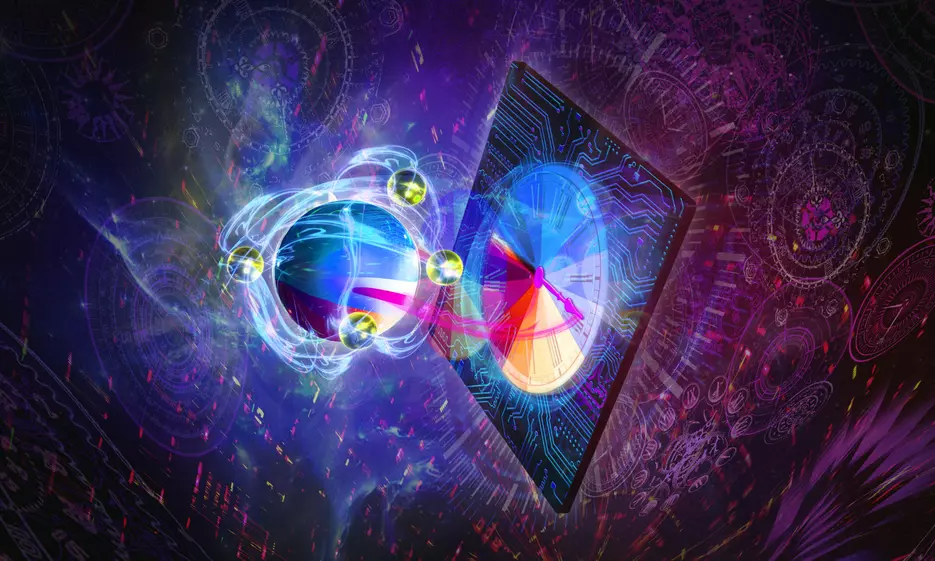Two groups of physicists, guided by Peter Zoller and Thomas Monz, have engineered the first programmable quantum sensor and verified it in the lab. To achieve this, they applied methods from quantum information processing to a measurement issue. The ground-breaking technique promises quantum sensors that will reach a precision level close to the boundary set by the laws of nature.
 Time could be determined even more precisely with sophisticated computational methods on entangled atoms. Physicists from Innsbruck, Austria, have developed such a technique. Image Credit: Uni Innsbruck/Harald Ritsch.
Time could be determined even more precisely with sophisticated computational methods on entangled atoms. Physicists from Innsbruck, Austria, have developed such a technique. Image Credit: Uni Innsbruck/Harald Ritsch.
Atomic clocks are some of the best sensors to have ever been built. Currently, they can be spotted in satellites of navigation systems or national standards institutes. Researchers around the world are aiming to further enhance the precision of these clocks.
Presently, a research team led by Peter Zoller, a theorist from the University of Innsbruck, Austria, has formulated a novel concept that can be used to establish sensors with even better precision regardless of which technical system is used to build the sensor.
“We answer the question of how precise a sensor can be with existing control capabilities, and give a recipe for how this can be achieved,” explain Denis Vasilyev and Raphael Kaubrügger from Peter Zoller's team at the Institute of Quantum Optics and Quantum Information at the Austrian Academy of Sciences in the University of Innsbruck.
Therefore, the physicists use a technique from quantum information processing: variational quantum algorithms illustrate a circuit of quantum gates that relies on free parameters. Through optimization standards, the sensor autonomously locates the paramount settings for an ideal result.
“We applied this technique to a problem from metrology - the science of measurement,” Vasilyev and Kaubrügger explain.
This is exciting because historically advances in atomic physics were motivated by metrology, and in turn quantum information processing emerged from that. So, we've come full circle here.
Peter Zoller, Study Lead and Theorist, University of Innsbruck
With the new method, researchers can enhance quantum sensors to the level where they accomplish the best conceivable precision technically admissible.
Better Measurements with Little Extra Effort
For a while, it has been believed that atomic clocks could work even more precisely by manipulating quantum mechanical entanglement. But, there has been a lack of approaches to realize strong entanglement for such uses.
The physicists are currently using custom-made entanglement that is accurately adjusted to practical requirements. With their technique, they produce precisely the combination containing quantum state and measurements that are ideal for each separate quantum sensor. This allows the sensor’s precision to reach near the optimum possible consistent with the laws of nature, with only a minor increase in overhead.
In the development of quantum computers, we have learned to create tailored entangled states. We are now using this knowledge to build better sensors.
Christian Marciniak, Department of Experimental Physics, University of Innsbruck
Demonstrating Quantum Advantage with Sensors
For the first time, this theoretical idea was executed in practice at the University of Innsbruck, as the research team guided by Thomas Monz and Rainer Blatt at present reported in Nature. The physicists carried out frequency measurements on their ion trap quantum computer according to variational quantum calculations.
Since the interactions used linear ion traps that are still comparatively easy to mimic on traditional computers, they were able to verify the essential factors on a supercomputer at the University of Innsbruck. Although the experimental arrangement is by no means flawless, the outcomes agree amazingly well with the theoretically projected values.
As such simulations are not possible for all sensors, the researchers showed a second method: They used approaches to automatically enhance the parameters without past knowledge.
“Similar to machine learning, the programmable quantum computer finds its optimal mode autonomously as a high-precision sensor”, says experimental physicist Thomas Feldker, illustrating the underlying mechanism.
Our concept makes it possible to demonstrate the advantage of quantum technologies over classical computers on a problem of practical relevance. We have demonstrated a crucial component of quantum-enhanced atomic clocks with our variational Ramsey interferometry.
Peter Zoller, Study Lead and Theorist, University of Innsbruck
“Running this in a dedicated atomic clock is the next step. What has so far only been shown for calculations of questionable practical relevance could now be demonstrated with a programmable quantum sensor in the near future – quantum advantage,” Peter Zoller added.
The study received financial support from the Austrian Science Fund FWF, the Research Promotion Agency FFG, the European Union within the framework of the Quantum Flagship and the Federation of Austrian Industries Tyrol, among others.
The results were published in the journals Physical Review X and Nature.
Journal References: